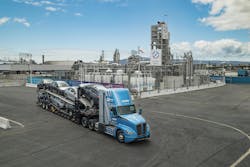Toyota Celebrates Grand Opening of Renewable Powered Logistics Facility
Toyota celebrated the grand opening of its “Tri-gen” powered vehicle processing and distribution center at the Port of Long Beach, California, today.
Toyota Logistics Services (TLS) at Long Beach is now fully powered by on-site renewable energy thanks to FuelCell Energy’s Tri-gen system. FuelCell Energy is a manufacturer of fuel cell technology platforms.
Tri-gen uses renewable biogas in a combustion-free process to produce renewable electricity, renewable hydrogen and usable water. The process emits virtually no air pollutants.
TLS is utilizing all three end products to reduce the carbon dioxide emissions of its Long Beach facility and make operations more sustainable. It is expected that the Tri-gen system will reduce more than 9,000 tons of carbon dioxide emissions each year and avoid more than six tons of harmful NOx emissions.
“The green power generated by the Tri-gen system, and similar projects, is part of our multilayered strategy to fuel our goal to become the world’s first zero-emissions port,” said Mario Cordero, CEO of the Port of Long Beach.
Nothing goes to waste
The 2.3 MW of renewable electricity generated by the system is powering TLS’ port operations. Any excess electricity is sent to Southern California Edison as part of the California Bioenergy Market Adjustment Tariff program, providing the utility with a renewable, resilient and affordable electric generation resource.
The Tri-gen system can produce up to 1,200 kg of renewable hydrogen per day and can be ramped up and down based on demand. Since the facility’s construction was completed last September, some of the renewable hydrogen has been fueling the automaker’s Mirai, a fuel cell electric vehicle (FCEV).
Renewable hydrogen is also used to fuel TLS drayage and logistics vehicles at the port, including a FCEV Kenworth T680 Class 8 truck. It’s expected that utilizing Class 8 FCEVs for port operations could reduce annual diesel consumption by over 420,000 gallons.
Finally, the 1,400 gallons of water produced as a byproduct of the hydrogen generation process is being used to wash cars that come into the port prior to their delivery to the customer, reducing TLS’ demand on the local water supply.
“This groundbreaking facility shows that there are ways to reduce our emissions and burden on natural resources with scalable technology based on hydrogen,” said Tom Stricker, group vice president of sustainability and regulatory affairs at Toyota.
New rules on zero-emissions vehicles
All new drayage trucks registered in California must be zero-emissions vehicles (ZEV) as of the beginning of this year, when the California Advanced Clean Fleet Regulation went into effect. That same regulation mandates that all drayage vehicles be ZEVs by 2035, so the move to hydrogen future-proofs TLS’ port operations. Drayage vehicles are the Class 7 and 8 vehicles that transport containers to and from seaports and intermodal rail yards.
“Tri-gen demonstrates that hydrogen-based energy can benefit businesses, deliver zero-emission transportation for light- and heavy-duty vehicles, support improved air quality in local communities, reduce water usage, and deliver immediate and long-term benefits to the environment,” FuelCell Energy CEO and President Jason Few said.
About the Author
Kathy Hitchens
Special Projects Editor
I work as a writer and special projects editor for Microgrid Knowledge. I have over 30 years of writing experience, working with a variety of companies in the renewable energy, electric vehicle and utility sector, as well as those in the entertainment, education, and financial industries. I have a BFA in Media Arts from the University of Arizona and a MBA from the University of Denver.

